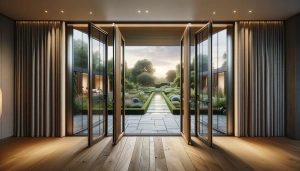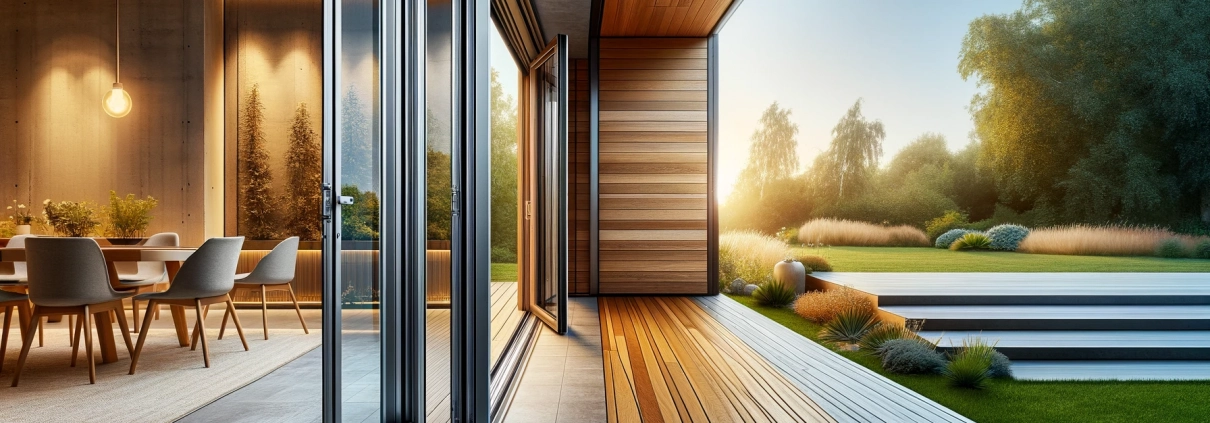Bi-folding Door Materials
Exploring Bi-Folding Door Materials: Choosing the Right Option for Your Space
Table of Contents
Bi-folding doors have become a popular feature in modern architecture, merging functionality with aesthetic appeal. These doors not only enhance the visual connectivity between indoor and outdoor spaces but also offer practical benefits in terms of space-saving and light enhancement. An essential aspect of bi-folding doors is the material used, which influences their durability, appearance, and efficiency. This article explores the materials commonly used in bi-folding doors, helping you make an informed decision for your space.

Understanding Bi-folding Doors
Definition and Functionality
Bi-folding doors, also known as accordion or folding sliding doors, consist of multiple panels that fold back like a concertina. Unlike traditional sliding doors, they can open up an entire wall, seamlessly connecting the indoors with the outdoors. This functionality makes them ideal for homes or commercial spaces looking to maximise natural light and create an expansive feel.
Benefits of Bi-folding Doors in Modern Architecture
Incorporating bi-folding doors into a building design offers numerous benefits. They provide a modern, sleek look, increase natural light, and can enhance the perceived size of a room. Their ability to blend indoor and outdoor spaces makes them particularly desirable in homes with gardens or beautiful views.
Overview of Common Materials Used
Aluminium-Durable and Lightweight
Aluminium is a popular choice for bi-folding doors due to its strength, durability, and light weight. This material is resistant to warping and corrosion, making it ideal for maintaining its shape and functionality over time. Aluminium doors can be finished in a wide range of colours and textures, offering great flexibility in design.
Timber-Traditional and Elegant
Timber offers a classic and elegant look, bringing warmth and character to bi-folding doors. It’s a preferred choice for traditional or period-style properties. However, timber requires more maintenance than other materials, as it is prone to warping and rotting if not properly treated and protected from the elements.
Innovative Materials in Bi-folding Doors
UPVC cost-effective and low-maintenance
UPVC (unplasticized polyvinyl chloride) is a cost-effective and low-maintenance option for bi-folding doors. It’s resistant to weathering, rot, and fading, making it a practical choice. While UPVC may not offer the same aesthetic appeal as aluminium or timber, it’s a reliable option for those on a budget.
Composite Materials – The Best of Both Worlds
Composite materials in bi-folding doors combine the benefits of different materials, such as timber and aluminium. These doors often feature a timber interior for aesthetic appeal and an aluminium exterior for durability. This combination offers both the traditional look of wood and the resilience of metal.
Aesthetic Appeal and Design Flexibility
Visual Impact of Different Materials
The choice of material for bi-folding doors significantly impacts their aesthetic appeal. Aluminium doors, with their sleek and modern appearance, can be powder-coated in a wide range of colours, offering versatility for contemporary designs. Timber, with its natural grains and textures, brings a classic and warm feel, ideal for traditional or rustic settings. UPVC, while somewhat limited in aesthetic versatility compared to aluminium and timber, offers a clean and crisp appearance.
Customisation and Style Options
When it comes to customising bi-folding doors, each material offers distinct possibilities. Aluminium doors can be customised in terms of colour, finish, and even frame size, allowing for a high degree of personalisation. Timber doors can be stained or painted to match the interior or exterior décor, offering a bespoke feel. Composite doors combine the customisation options of both timber and aluminium, providing a balance of style and functionality.
Durability and Maintenance
Longevity and Weather Resistance
When it comes to durability, the choice of material plays a significant role. Aluminium and composite materials tend to offer the highest resistance to weathering and require minimal maintenance. Timber, while beautiful, may need regular treatment to maintain its appearance and integrity.
Maintenance Requirements for Each Material
Maintenance is an important consideration in the choice of material for bi-folding doors. Aluminium and UPVC are ow-maintenance; they typically need only occasional cleaning to keep them looking good. Timber, on the other hand, may require periodic sanding, painting, or varnishing to protect it from the elements and prevent deterioration.
Thermal Efficiency and Insulation
Energy Efficiency of Materials
The thermal efficiency of bi-folding doors depends largely on the material used. Aluminium doors, especially those with a thermal break, are excellent at preventing heat transfer, making them energy efficient. Timber naturally has good insulating properties, helping to keep the indoor temperature stable. UPVC is also effective for insulation, often incorporating multi-chambered profiles to enhance thermal performance.
Impact on Indoor Comfort
The choice of material affects not only energy bills but also the comfort level inside your home. Materials that provide better insulation contribute to a consistent indoor climate, reducing the need for excessive heating or cooling. This aspect is particularly important in areas experiencing extreme weather conditions.
Cost Comparison and Value for Money
Initial Investment and Long-Term Value
The cost of bi-folding doors varies with the material. Aluminium doors, while offering durability and low maintenance, can be more expensive initially. Timber doors are also at the higher end of the price spectrum but offer timeless elegance. UPVC doors are generally the most cost-effective option, providing a balance of performance and affordability. When considering cost, it’s also important to factor in the longevity and maintenance requirements, which affect the long-term value of your investment.
Balancing Budget and Quality
Choosing the right material for bi-folding doors involves balancing your budget with the quality and performance you expect. Aluminium and composite doors, though pricier, offer durability and minimal maintenance, while timber doors provide a classic look but require regular upkeep. UPVC doors can be a more budget-friendly option but may not match the strength and aesthetic of the other materials.
Environmental Impact and Sustainability
Eco-Friendliness of Materials
The environmental impact of bi-folding door materials is an important consideration. Aluminium is highly recyclable, reducing its environmental footprint. Timber, if sourced sustainably, can be an eco-friendly option, though its production and maintenance can have environmental implications. UPVC is less environmentally friendly due to its production process and difficulty in recycling.
Sustainable Choices in Bi-folding Doors
For those seeking sustainable options, choosing materials like recycled aluminium or FSC-certified timber can be beneficial. Composite doors that combine materials efficiently can also be a more sustainable choice, offering durability and reducing the need for replacement or maintenance.
Making the Right Choice for Your Needs
Assessing Individual Requirements
Selecting the ideal material for bi-folding doors depends on individual requirements, including aesthetic preferences, budget constraints, and environmental concerns. Consider the climate, the architectural style of your property, and how the doors will be used to determine the most suitable material.
Future Trends and Innovations in Materials
Staying informed about future trends and innovations in bi-folding door materials can also guide your decision. Advances in materials science may lead to more sustainable, durable, and efficient options in the future, offering enhanced choices for homeowners and builders. In conclusion, bi-folding doors offer a blend of functionality and aesthetic appeal, with each material providing unique benefits. Whether it’s the durability and modern look of aluminium, the natural elegance of timber, the cost-effectiveness of UPVC, or the balanced attributes of composite materials, the right choice depends on a variety of factors, including personal preference, practicality, and environmental impact. By carefully considering these aspects, you can select a bi-folding door that not only enhances your space but also aligns with your broader architectural and lifestyle goals.





